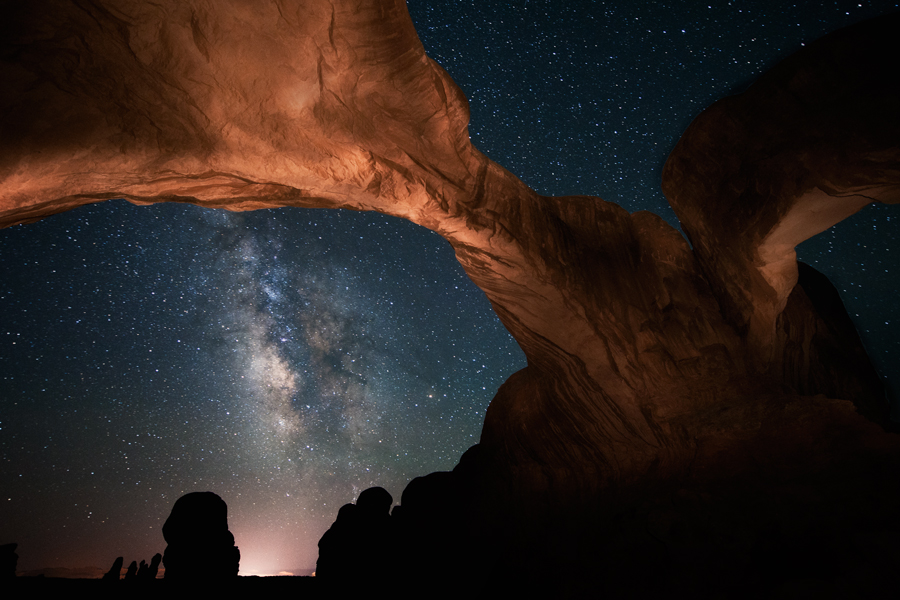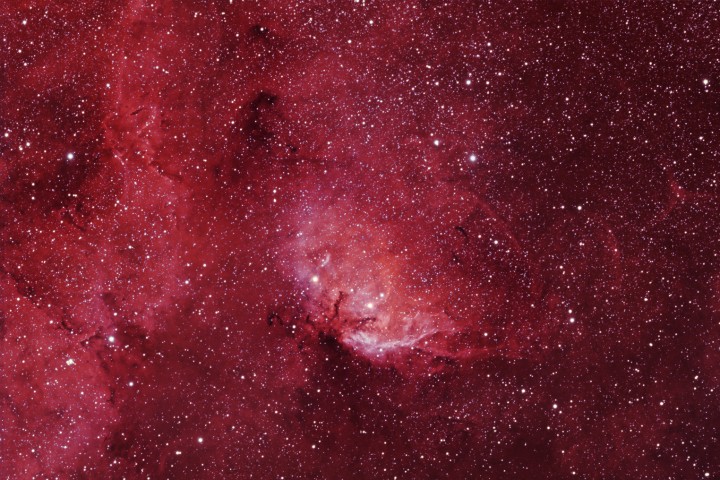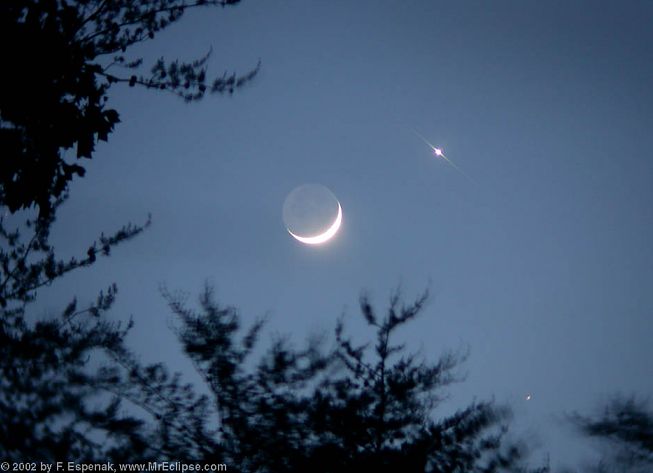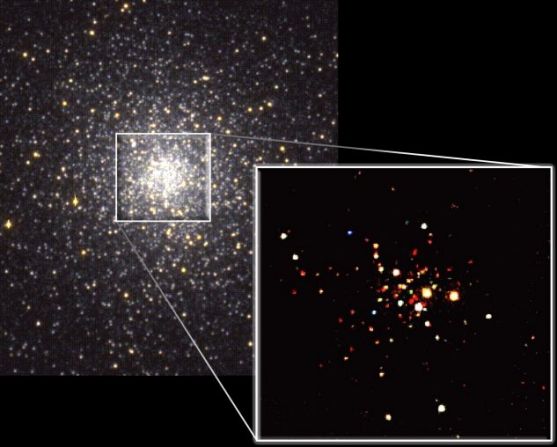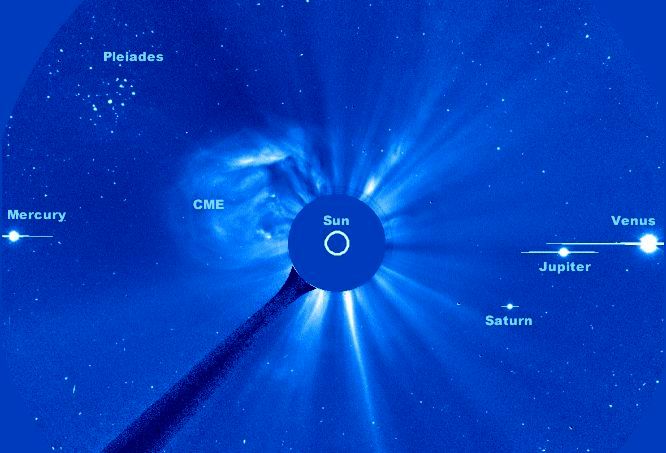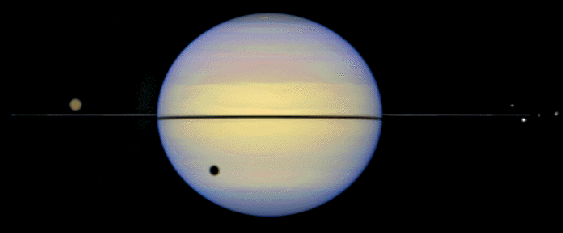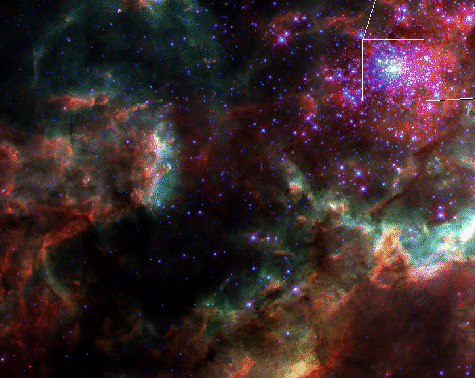| << Previous | Index | Next >> |
2015 What's that rising from the clouds? The space shuttle. Sometimes, if you looked out the window of an airplane at just the right place and time, you could have seen something very unusual -- a space shuttle launching to orbit. Images of the rising shuttle and its plume became widely circulated over the web shortly after Endeavour's final launch in 2011 May. The above image was taken from a shuttle training aircraft by NASA and is not copyrighted. Taken well above the clouds, the image can be matched with similar images of the same shuttle plume taken below the clouds. Hot glowing gasses expelled by the engines are visible near the rising shuttle, as well as a long smoke plume. A shadow of the plume appears on the cloud deck, indicating the direction of the Sun. The US Space Shuttle program concluded in 2011, and Endeavour can now be visited at the California Science Center.
2014 Why would clouds appear to be different colors? The reason here is that ice crystals in distant cirrus clouds are acting like little floating prisms. Sometimes known as a fire rainbow for its flame-like appearance, a circumhorizon arc lies parallel to the horizon. For a circumhorizontal arc to be visible, the Sun must be at least 58 degrees high in a sky where cirrus clouds are present. Furthermore, the numerous, flat, hexagonal ice-crystals that compose the cirrus cloud must be aligned horizontally to properly refract sunlight in a collectively similar manner. Therefore, circumhorizontal arcs are quite unusual to see. This circumhorizon display was photographed through a polarized lens above Dublin, Ohio in 2009.
2013 A close series of consecutive exposures are combined in this intriguing composite of the Full Moon slowly crawling, across the sky. Beginning on the upper right at 19:42 UT and ending at 22:14 UT on April 25, the sequence follows the Moon from Germany as it passes through Earth's shadow in a partial lunar eclipse. Near the top, the Moon just grazes the southern edge of Earth's dark central shadow, or umbra. But the decreased brightness in the darker part of the outer shadow region, the penumbra, is also apparent on the lunar disk. In fact, the relative size and shape of the Earth's shadow regions and the Moon are easier to see along the segments of this lunar caterpillar. Nearly impossible to follow with the eye though, a penumbral lunar eclipse, the Full Moon passing only through the pale outer penumbral shadow, will begin on May 25.
2012
2011 How many arches can you count in the above image? If you count both spans of the Double Arch in the Arches National Park in Utah, USA, then two. But since the above image was taken during a clear dark night, it caught a photogenic third arch far in the distance -- that of the overreaching Milky Way Galaxy. Because we are situated in the midst of the spiral Milky Way Galaxy, the band of the central disk appears all around us. The sandstone arches of the Double Arch were formed from the erosion of falling water. The larger arch rises over 30 meters above the surrounding salt bed and spans close to 50 meters across. The dark silhouettes across the image bottom are sandstone monoliths left over from silt-filled crevices in an evaporated 300 million year old salty sea. A dim flow created by light pollution from Moab, Utah can also be seen in the distance.
2010 The clouds surrounding the star system Rho Ophiuchi compose one of the closest star forming regions. Rho Ophiuchi itself is a binary star system visible in the light-colored region on the image right. The star system, located only 400 light years away, is distinguished by its colorful surroundings, which include a red emission nebula and numerous light and dark brown dust lanes. Near the upper right of the Rho Ophiuchi molecular cloud system is the yellow star Antares, while a distant but coincidently-superposed globular cluster of stars, M4, is visible between Antares and the red emission nebula. Near the image bottom lies IC 4592, the Blue Horsehead nebula. The blue glow that surrounds the Blue Horsehead's eye -- and other stars around the image -- is a reflection nebula composed of fine dust. On the above image left is a geometrically angled reflection nebula cataloged as Sharpless 1. Here, the bright star near the dust vortex creates the light of surrounding reflection nebula. Although most of these features are visible through a small telescope pointed toward the constellations of Ophiuchus, Scorpius, and Sagittarius, the only way to see the intricate details of the dust swirls, as featured above, is to use a long exposure camera.
2009
2008 Still bathed in sunlight, the International Space Station tracked through night skies above Hombressen, Germany on May 12. From a range of at least 360 kilometers, astronomer Dirk Ewers was able to record an impressively sharp video sequence of the passage with a small telescope, using some of the individual frames to construct this composite image. Sporting solar arrays, the station's integrated truss structure is nearly 90 meters long. The ATV Jules Verne is docked with the station, while the space station itself is orbiting at aproximately 27,800 kilometers per hour (17,200 mph). A complete video sequence is available as a 1 megabyte mpeg file or avi file.
2007 This expansive (1-degree wide) telescopic view looks out along the plane of our Milky Way Galaxy toward the nebula rich constellation Cygnus the Swan. It is centered on a bright hydrogen emission region recorded in the 1959 catalog by astronomer Stewart Sharpless as Sh2-101. About 8,000 light-years distant the nebula is popularly known as the Tulip Nebula, understandably not the only cosmic cloud to evoke the imagery of flowers. Complex and beautiful in visible light, the area also includes one of the brightest, most famous sources in the x-ray sky, Cygnus X-1. Discovered in the early 1970s, Cygnus X-1 is a bizarre binary system consisting of a massive, hot, supergiant star (seen here) in close orbit with a stellar mass black hole. The Cygnus X-1 system is also estimated to lie a comfortable 8,000 light-years away.
2006 What's happening near the center of this cluster of galaxies? At first glance, it appears that several strangely elongated galaxies and fully five bright quasars exist there. In reality, an entire cluster of galaxies is acting as a gigantic gravitational lens that distorts and multiply-images bright objects that occur far in the distance. The five bright white points near the cluster center are actually images of a single distant quasar. This Hubble Space Telescope image is so detailed that even the host galaxy surrounding the quasar is visible. Close inspection of the above image will reveal that the arced galaxies at 2 and 4 o'clock are actually gravitationally lensed images of the same galaxy. A third image of that galaxy can be found at about 10 o'clock from the cluster center. Serendipitously, numerous strange and distant galaxies dot the above image like colorful jewels. The cluster of galaxy that acts as the huge gravitational lens is cataloged as SDSS J1004+4112 and lies about 7 billion light years distant toward the constellation of Leo Minor.
2005 Swirls of gas and dust enrich this little observed starfield toward the constellation of Sagittarius. Just to the side of the more often photographed Lagoon Nebula (M8) and the Trifid Nebula (M20) lies this busy patch of sky dubbed IC 4678. Prominent in the above image are large emission nebulas of red glowing gas highlighted by unusually bright red filaments. On the left, a band of thin dust preferentially reflects the blue light of a bright star creating a small reflection nebula. On the right and across the bottom, swaths of thicker dust appear as dark absorption nebulas, blocking the light from stars farther in the distance. IC 4678 spans about 25 light years and lies about 5,000 light years distant.
2004
[imghover6=http://apod.nasa.gov/apod/image/0405/ei ... alfalk.jpg]http://apod.nasa.gov/apod/image/0405/ei ... alfalk.jpg[/imghover6]Credit & Copyright: Magnus Galfalk (Stockholm Observatory)
2003 If not perfect, then this spiral galaxy is at least one of the most photogenic. An island universe of about 100 billion stars, 30 million light-years away toward the constellation Pisces, NGC 628 or M74 presents a gorgeous face-on view to earthbound astronomers. Classified as an Sc galaxy, the grand design of M74's graceful spiral arms traced by bright blue star clusters and dark cosmic dust lanes, is similar in many respects to our own home galaxy, the Milky Way. Recorded with a 28 million pixel detector array, this impressive image celebrated first light for the Gemini Multi-Object Spectrograph (GMOS), a state-of-the-art instrument operational at the 8-meter Gemini North telescope. The Gemini North Observatory gazes into the skies above Mauna Kea, Hawaii, USA, while its twin observatory, Gemini South, operates from Cerro Pachón in central Chile.
2002 Venus, named for the Roman goddess of love, and Mars, the war god's namesake, approach each other by moonlight in this lovely sky view recorded on May 14th from Dunkirk, Maryland, USA. The four second time exposure made in twilight with a digital camera also records earthshine illuminating the otherwise dark surface of the young crescent Moon. Venus shines as the third brightest object in Earth's sky, after the Sun and the Moon itself, and has been appearing as the brilliant evening star in the pantheon of planets arrayed in the west during April and May. Here, Venus' light is so intense that it produces a noticeable spike in the sensitive camera's image. Much fainter Mars is lower in the picture, caught between tree limbs swaying in a gentle evening breeze. By early June, Mars will be harder to spot as it wanders toward the horizon, but Venus and father Jupiter will draw closer together, presenting a spectacular pair of bright planets in the west.
2001
2000 Bright stars of the Pleiades, four planets, and erupting solar plasma are all captured in this spectacular image from the space-based SOlar and Heliospheric Observatory (SOHO). In the foreground of the 15 degree wide field of view, a bubble of hot plasma, called a Coronal Mass Ejection (CME), is blasting away from the active Sun whose position and relative size is indicated by the central white circle. Beyond appear four of the five naked-eye planets -- courtesy of the planetary alignment which did not destroy the world! In the background are distant stars and the famous Pleiades star cluster, also easily visible to the unaided eye when it shines in the night sky. Distances for these familiar celestial objects are; the Sun, 150 million kilometers away; Mercury, Venus, Jupiter, and Saturn, about 58, 110, 780, and 1,400 million kilometers beyond the Sun respectively; and the Pleiades star cluster at a mere 3,800 trillion kilometers (400 light-years). SOHO itself orbits 1.5 million kilometers sunward of planet Earth. The image was recorded by the Large Angle and Spectrometric COronagraph (LASCO) instrument on board SOHO on Monday, May 15 at 10:42 UT.
1999 A bright nova was discovered Saturday that is currently visible to the unaided eye in southern skies. Nova Velorum 1999 was recorded near visual magnitude 3 independently by discoverers Peter Williams and Alan C. Gilmore (Mt. John U. Obs.), making it more luminous than many famous bright stars. The last nova this bright was Nova Cygni 1975, which peaked just brighter than magnitude 2. Nova Velorum 1999 is brighter now than the well-studied Nova Cygni 1992 ever appeared. A nova occurs when the surface of a white dwarf star undergoes a tremendous thermonuclear explosion, throwing off its outer layers. How the nova will appear over the next few weeks is uncertain, but the exploding debris will likely fade beyond detectability over the next few years. The above photograph of Nova Velorum 1999 was taken yesterday from Australia. The cross-hair like spikes that appear around it were caused by the photographing telescope and camera.
1998 Looking like a fleet of futuristic starcruisers, NASA's highly successful series of High Energy Astrophysical Observatory (HEAO) spacecraft appear poised over planet Earth. Labeled A, B, and C in this vintage illustration, the spacebased telescopes were known as HEAO-1, HEAO-2, and HEAO-3 respectively. HEAO-1 and HEAO-2 were responsible for revealing to earthlings the wonders of the x-ray sky, discovering 1,000s of celestial sources of high-energy radiation. HEAO-2, also known as the Einstein Observatory, was launched near the date of the famous physicist's 100th birthday (November, 1978) and was the first large, fully imaging x-ray telescope in space. HEAO-3, the last in the series, was launched in 1979 and measured high energy cosmic-ray particles and gamma-rays. These satellite observatories were roughly 18 feet long and weighed about 7,000 pounds. Their missions completed, all have fallen from orbit and burned up harmessly in the atmosphere.
1997 Saturn's rings are actually very thin. This picture from the Hubble Space Telescope was taken on August 6, 1995 when the rings lined up sideways as seen from Earth. Saturn's largest moon Titan is seen on the left, and Titan's shadow can be seen on Saturn's cloud tops! Titan itself looks a brownish color because of its thick atmosphere. Four other moon's of Saturn can be seen just above the ring plane, which are, from left to right: Mimas, Tethys, Janus, and Enceladus. If you look carefully, you will note that the dark band across the planet is actually the shadow of the rings, and is slightly displaced from the real rings - which are best seen away from the planet. Saturn's rings are not solid - they are composed of ice chunks which range in size from a grain of sand to a house.
1996 In the center of 30 Doradus lies a huge cluster of the largest, hottest, most massive stars known. The center of this cluster, known as R136, is boxed in the upper right portion of the above picture. The gas and dust filling the rest of the picture is predominantly ionized hydrogen from the emission nebula 30 Doradus. R136 is composed of thousands of hot blue stars, some about 50 times more massive than our Sun. 30 Doradus and R136 lie in the LMC - a satellite galaxy to our own Milky Way Galaxy. Although the ages of stars in R136 cause it to be best described as an open cluster, R136's density will likely make it a low mass globular cluster in a few billion years.
| << Previous | Index | Next >> |




